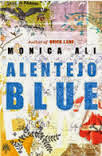Tuesday, 15 October 2013
The Testament of Mary by Colm Toibin
A short but direct novel that makes a striking impact. Written in the first person taking the voice of Mary, it is confessional in tone. Mary is determined to set the record straight, failing to comprehend the special place of her son as the ‘Son of God’ but fully aware of how his painful end is the result of political manipulation by both the Jewish and Roman authorities. Moreover, she is very aware of the motives of her guardians who already in the process of writing an account of the life and death of their her son with a clear eye for posterity. In hiding, in Ephesus, Mary knows what she felt and saw and that this is not what the guardians are hoping from her. She also knows that her own death is near and is determined to die without her knowledge of the truth being compromised. This is a very political novel and forces the reader to reflect long and hard on the nature of evidence.
Alentejo Blue by Monica Ali
A story of change in a rural village in Portugal told through many voices, both local and foreign. Ultimately it is a story of rural decline and the vain hope that it can be arrested in the face of young people emigrating and the inconsistency of the new arrivals seeking some sort of future in the sun. Because of the multiple voices each one having only a remote connection to the previous one, it doesn’t quite hang together as a novel. Having said that, it does contain beautiful and perceptive writing with credible characters, the young with their aspirations, some more ambitious than others, and the old with their memories of sterner times and biting poverty. Since it is set in the Alentejo, cork and its gradual decline as a stopper for wine bottles is constantly in the background as is a rather fanatical form of Catholicism. However, the cultural clash between a very traditional society and the newcomers from all over Europe seems to be becoming less marked, and in the character of Vasco, a local having spent many years in the US, acts as a bridge between the old world and the new – both physically and metaphorically. Overall, I enjoyed this book, although I became a little impatient with some of the characters, Chrissie and her wastrel husband China, for example. Although towards the end, even they clean up their messy lifestyle. Not all the loose ends are well-tied however, and this reflects the basic problem with writing a fictional account of a real life community, it is a continuing story and one which I hope Monica Ali returns to in a few years.
Wednesday, 9 October 2013
How I Live Now by Meg Rosoff
A gripping tale of loss, suffering and love told in the voice of a teenage American girl trapped in England with her English cousins when a world war breaks out. Not sure who the enemy is, but I think the author was imagining the sort of people who perpetrated 9/11 operating on a global basis. The tension is palpable throughout as is the terror. The casual and brutal murders of Joe and Major McEvoy and the discovery of what had happened at Gateshead Farm are described in compelling detail, the sheer horror of these events propel the second half of the book. The backwoods skills involved in Daisy and Piper’s long trek home are very real and the few moments of happiness amidst the terrible reality of their hunger and fear are very poignant. I found it impossible to predict the ending and when it came its intensity was startling. This is a rite-of-passage tale told with great delicacy and sympathy. And what’s worrying is that the events recounted in this story could happen, and they could happen sometime soon. reminded me of Golding's Lord of the Flies. Well worth reading and cogitating on.
Saturday, 5 October 2013
44 Scotland Street by Alexander McCall Smith
How unusual to read a book that was originally serialised in a newspaper - very Dickensian. But what a wonderful range of characters, no real villains, although Irene comes close. Pat, our heroine, is drifting through life and loves on her second gap year working in an economically-challenged art gallery. We are to understand that her first gap year was a bit of a disaster but we are given no detail. Her temporary infatuation with the rugger-bugger flatmate, Bruce, was bound to end in tears as any reader would have told her. And that is the attraction of the book, we readers know these characters, we seem to have known them for years, they are our friends as well as Pat’s, even Ian Rankin who has a brief cameo part, and we wish them well. Fascinating though Irene and her precocious son, Bertie are, it is Domenica and Angus who are potentially the more interesting human characters. As for the non-human characters Cyril, the beer-drinking dog, is enchanting, but it is Edinburgh itself with its good-heartedness and genteel bourgeois world that captivates. We will undoubtedly miss all this when Scotland votes for independence next year, and this will be a great loss to British cultural life
Subscribe to:
Posts (Atom)




